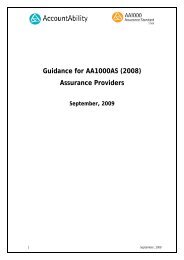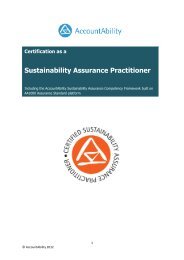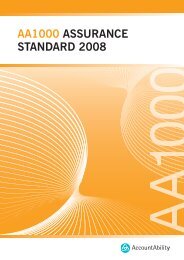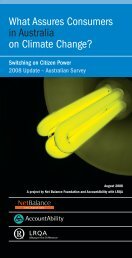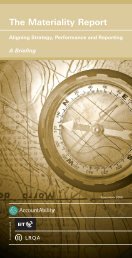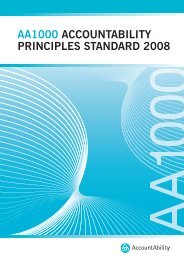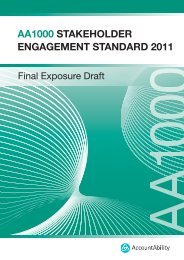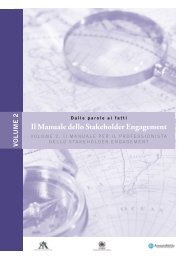The Stakeholder Engagement Manual Volume 2 - AccountAbility
The Stakeholder Engagement Manual Volume 2 - AccountAbility
The Stakeholder Engagement Manual Volume 2 - AccountAbility
Create successful ePaper yourself
Turn your PDF publications into a flip-book with our unique Google optimized e-Paper software.
<strong>Stakeholder</strong> dependence on<br />
the organisation<br />
STAGE 1<br />
Further to my points above, it's important to note that dialogue doesn't necessarily<br />
stop or 'just' become formaised once an issue becomes inststutionalised.<br />
Between defensive and opportunity focused companies, there is a spectrum<br />
of approaches where companies take an increasingly proactive and embedded<br />
approach to addressing issues raised by stakeholders.<br />
Prioritising according to the infl uence and dependence of stakeholders<br />
Another way to approach the question of strategic alignment is identifying those<br />
stakeholders that are likely to have the greatest impact on the achievement of<br />
your strategic objectives, and those stakeholders that will be most positively or<br />
negatively impacted by the company’s operations. Th is will enable you to prioritise<br />
your attention and action to ensure that you can achieve your strategic objectives,<br />
while respecting the rights of signifi cantly impacted stakeholders.<br />
In order to ensure this, a company might prioritise stakeholder groups in this way:<br />
<strong>Stakeholder</strong> Infl uence and Dependancy Matrix<br />
High<br />
Low<br />
Low<br />
Treat fairly – honour commitments to<br />
these stakeholders in line with company<br />
policy, regulations and industry norms,<br />
otherwise endeavour to keep stakeholders<br />
satisfi ed insofar as balance of costs and<br />
benefi ts allow.<br />
Low priority - provide access to general<br />
channels of information and feedback.<br />
<strong>Stakeholder</strong> infl uence on organisation<br />
Strategic threat or opportunity - invest in<br />
engagement processes to understand<br />
concerns and develop solutions.<br />
High<br />
Keep involved and informed, but ensure<br />
balance between the concerns of high<br />
infl uence stakeholders and those of people<br />
actually impacted by decisions.<br />
However, for any particular company or issue, such a matrix may need to be<br />
adjusted to refl ect the most relevant prioritisation criteria in each case. For<br />
example, instead of company dependence, one could consider the dependence<br />
of specifi c strategic business objectives, or of specifi c business divisions on the<br />
stakeholders, which would allow for a more specifi c prioritisation of stakeholders.<br />
Also, it is important to be aware of the interactions between the diff erent<br />
stakeholder groups, for example through lobbying or advocacy activities.<br />
One key driver for corporate responsibility in recent years has been the<br />
development of coalitions of diverse stakeholders around key issues. In particular,<br />
high infl uence /low dependency stakeholders such as investors and consumers<br />
have ‘lent their infl uence to low infl uence high dependency stakeholders such as<br />
supply chain workers in developing countries, future generations and animals,<br />
in order to focus corporate attention on issues such as supply chain labour<br />
conditions, environmental care and animal welfare.<br />
THE PRACTITIONER'S HANDBOOK ON STAKEHOLDER ENGAGEMENT | 43



